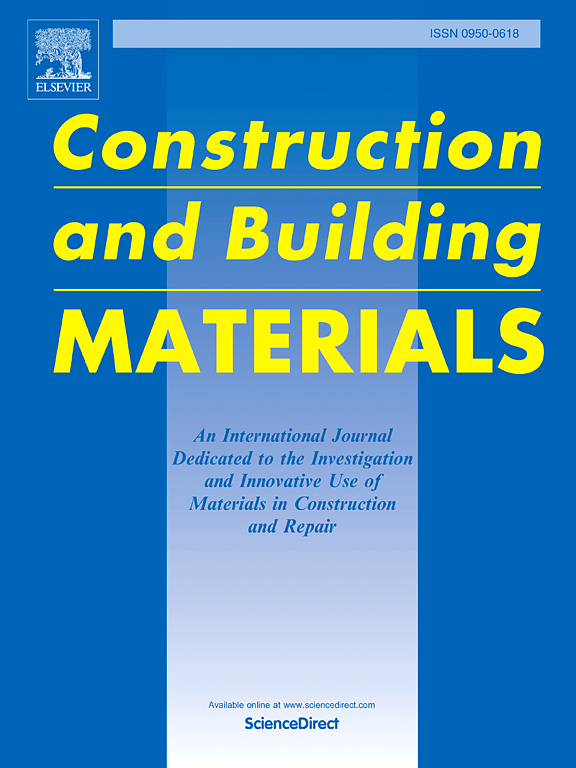纳米二氧化硅增强高性能磷酸镁水泥修补砂浆:界面粘结的优化
IF 8
1区 工程技术
Q1 CONSTRUCTION & BUILDING TECHNOLOGY
引用次数: 0
摘要
本研究探讨了纳米二氧化硅(NS)作为死烧氧化镁(MgO)的替代品对磷酸镁水泥(MPC)性能的影响,并评估了MPC-NS复合砂浆与普通硅酸盐水泥(OPC)基材之间的界面结合。本研究考察了不同的NS替代率(按MgO的质量,RM/N计算,从0 %到4 %)对MPC的凝固时间、抗压强度、弯曲粘结强度和拉伸粘结强度的影响。该调查特别关注诸如耐水性、固化年龄和基材表面粗糙度等因素。结果表明,NS的加入显著降低了MPC的初始凝固时间,达到17 min。3 % NS替代率可优化混凝土的力学性能和耐水性,浸水7 d,养护28 d,抗压强度达到58.45 MPa。与光滑表面相比,粗糙的OPC衬底表面显示界面结合强度提高了5.5-264 %。XRD、SEM-EDS、TGA-DTG等微观结构分析表明,30 nm的NS颗粒通过孔隙填充使MPC基体致密化。MgO的溶解释放出Mg2+和OH⁻,这进一步促进了无定形二氧化硅的溶解和M-S-H凝胶的持续生成。该工艺减少了界面晶相,加强了化学键,从而显著提高了MPC-NS砂浆与OPC之间的界面键合强度和耐久性。然而,过量的NS(4 %)会导致纳米颗粒团聚,增加砂浆的稠度,潜在地影响其均匀性和致密性,从而限制了机械性能和粘合性能的改善。这些发现为开发高性能、耐用、快速硬化的无机修复材料提供了坚实的基础。本文章由计算机程序翻译,如有差异,请以英文原文为准。
Nano-silica-enhanced high-performance magnesium phosphate cement repair mortars: Optimization of interfacial bonding
This study explored the effects of nano-silica (NS) as a substitute for dead-burned magnesium oxide (MgO) on the performance of magnesium phosphate cement (MPC) and assessed the interfacial bonding between MPC-NS composite mortar and ordinary Portland cement (OPC) substrates. This study scrutinizes the impact of varying NS replacement ratios (ranging from 0 % to 4 % by mass of MgO, RM/N) on the setting time, compressive strength, flexural bond strength, and tensile bond strength for MPC. The investigation places particular focus on factors such as water resistance, curing age, and substrate surface roughness. The results demonstrate that the inclusion of NS significantly reduces the initial setting time of MPC to 17 min. A 3 % NS replacement ratio was found to optimize mechanical performance and water resistance, achieving a compressive strength of 58.45 MPa after 7 days of water immersion followed by 28 days of curing. Roughening the surface of the OPC substrate was shown to increase interfacial bond strength by 5.5–264 % compared to smooth surfaces. Microstructural analysis using XRD, SEM-EDS, and TGA-DTG revealed that 30-nm NS particles densify the MPC matrix through pore-filling. The dissolution of MgO releases Mg2+ and OH⁻, which further promote the dissolution of amorphous silica and the sustained production of M-S-H gels. This process reduces interfacial crystalline phases and strengthens chemical bonds, thereby significantly enhancing the interfacial bond strength and durability between MPC-NS mortar and OPC. However, an excessive level of NS (4 %) can cause nanoparticle agglomeration and increase mortar consistency, potentially compromising its homogeneity and compactness, and thus limiting improvements in both mechanical and bonding performance. These findings provide a robust foundation for the development of high-performance, durable, and rapid-hardening inorganic repair materials.
求助全文
通过发布文献求助,成功后即可免费获取论文全文。
去求助
来源期刊

Construction and Building Materials
工程技术-材料科学:综合
CiteScore
13.80
自引率
21.60%
发文量
3632
审稿时长
82 days
期刊介绍:
Construction and Building Materials offers an international platform for sharing innovative and original research and development in the realm of construction and building materials, along with their practical applications in new projects and repair practices. The journal publishes a diverse array of pioneering research and application papers, detailing laboratory investigations and, to a limited extent, numerical analyses or reports on full-scale projects. Multi-part papers are discouraged.
Additionally, Construction and Building Materials features comprehensive case studies and insightful review articles that contribute to new insights in the field. Our focus is on papers related to construction materials, excluding those on structural engineering, geotechnics, and unbound highway layers. Covered materials and technologies encompass cement, concrete reinforcement, bricks and mortars, additives, corrosion technology, ceramics, timber, steel, polymers, glass fibers, recycled materials, bamboo, rammed earth, non-conventional building materials, bituminous materials, and applications in railway materials.
 求助内容:
求助内容: 应助结果提醒方式:
应助结果提醒方式:


